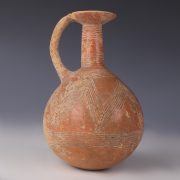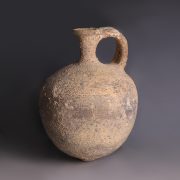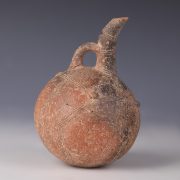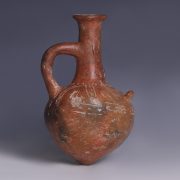Collecting Guide: Types of Ancient Greek Vase
Greek pottery is one of our main points of contact with the ancient world. Greek pots remain in abundance, beginning with those dating to the Minoan era (from around or even before 3000 BC) up until the end of the Hellenistic period (31 BC). As we might expect, they come in a variety of shapes and sizes according to their function. Understanding these different shapes has enabled us to date vases more accurately according to the evolution of trends we see in pottery over time. Greek pottery is often thought to have reached its apex in the fifth and sixth centuries BC. In order to make sense of the key different types, we have created a glossary – these types have been organised alphabetically for convenience.
In terms of Attic vase painting, black-figure is the type most often associated with Greek pottery – black figures against a red terracotta background. This was inverted by Athenian potters towards the end of the sixth century BC, and thus the red-figure type developed, with terracotta red figures against a glossy painted black background.
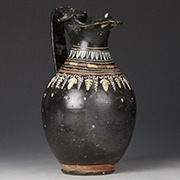
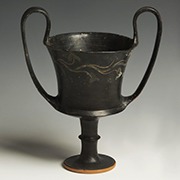
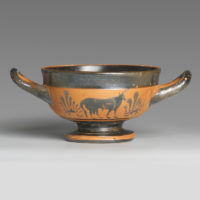
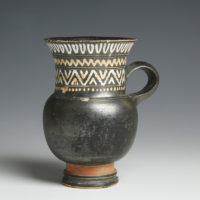
Alabastron
An alabastron was a small vessel that was primarily used for holding expensive oils, such as perfume. They tend to have a narrow body with a rounded end, and a narrow neck with an everted rim. They typically only let out small quantities of liquid at a time on account of their narrow necks, hence the convenience in using them for expensive goods.
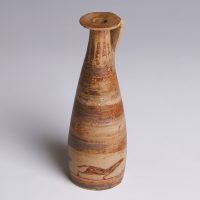
Amphora
This is one of the most common vessels we find in the ancient world. Amphorae were used for storing goods both liquid and dry. Often those used for actual storage purposes for in Greece are fairly plain and coarse, but we also find some splendid high-quality examples that were decorative, and designed either for social purposes (such as showing off at a symposium) or ritual.
Epichysis
Epichyseis were used for the pouring of expensive liquids, such as massage oils and perfumes – hence the beaked nature of the spout, designed to pour out only a small amount at a time.
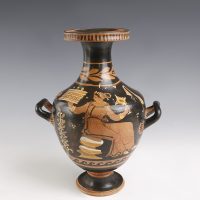
Hydria
A hydria, as the name suggests, was used for carrying water. Interestingly, they also occasionally would be used for holding ashes in a burial context, much like an urn, and also for collecting ballot papers in elections.
Kantharos
A kantharos was a type of cup used to hold wine, to drink from or for ceremonial purposes. It usually has a deep bowl, a tall foot and a pair of large handles. They are often well decorated, as they were frequently used in a social context – a key arena for self-promotion. The kantharos was also an attribute of the god Dionysus, who was often portrayed holding the particular cup.
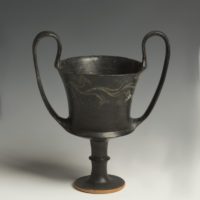
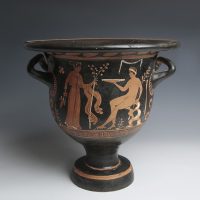
Krater
A krater was a large vessel – the largest known (the Vix Krater in France) measures 1.63 metres in its height. Their main use was to water down wine. This was not done by virtue of frugal hosting techniques, but in fact Greek wine, in its undiluted form, was incredibly strong. It would normally be mixed with water at a ratio of one part wine to five or six parts water – consequently, a large vessel was needed for this purpose.
Kyathos
A kyathos was essentially a tall bowl with a single, long, looped handle. It was used as we would use a ladle – for manoeuvring liquids and foodstuffs.
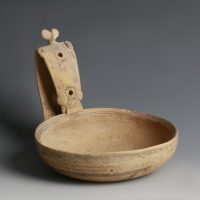
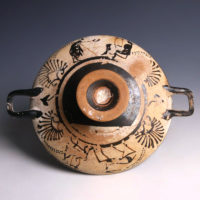
Kylix
A kylix was the most common vessel used for drinking wine. They are usually quite broad and shallow bowls, raised on a foot, with two handles. They tend to be decorated more intricately on the underside of the bowl, as this would be what others saw when it was being tilted to drink from. They are often decorated with light-hearted and humorous themes, sometimes alluding to the god of wine, Dionysus.
Lekythos
A lekythos was used for storing oil – most often olive oil. It is a fairly narrow vessel with a flat rim, and one would pour from it much as a jug. Many have been found in funerary contexts, as they were sometimes used for anointing dead bodies.
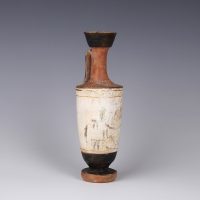
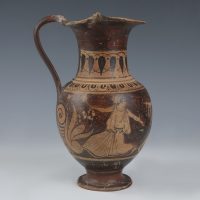
Oinochoe
An oinochoe was a jug specifically designed for the pouring of wine. There are many different forms of the oinochoe – the earliest being the olpe. They typically have only one handle at the back and a pouring spout – they are very similar in shape to our modern jugs.
Phiale
A phiale is the Greek equivalent to a Roman patera – a dish designated for the pouring of libations (wine offerings) to the gods. It was a shallow bowl often with an indentation on its underside to allow for holding it, as it did not have handles.
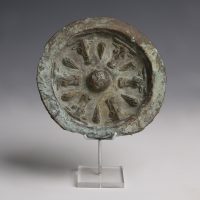
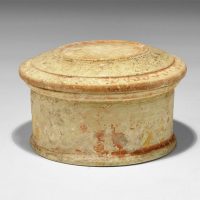
Pyxis
A pyxis was essentially a ceramic box. They were most often cylindrical in their shape and usually came with a separate ceramic lid. They were usually owned by women for holding jewellery, cosmetics or other trinkets.
Skyphos
Skyphoi were drinking cups (usually for wine) that feature deep bowls with two horizontal handles, usually with a low base. They were pioneered in Corinth during the Greek geometric period, circa 8th century BC. The skyphos was a popular shape and remained in use into the Roman period. Later examples of skyphoi have also been found in other materials, such as glass and silver. They were frequently used in symposia.
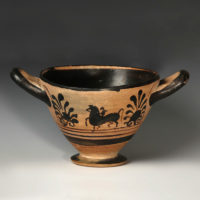
Ancient pottery from our collection…
Filed under: Ancient Greece, Buying & Collecting Tags: , Black-Figure Pottery, Greek Pottery, Greek Vases, Offerings to the Gods, Red-Figure Pottery
Comments: Comments Off on Collecting Guide: Types of Ancient Greek Vase
